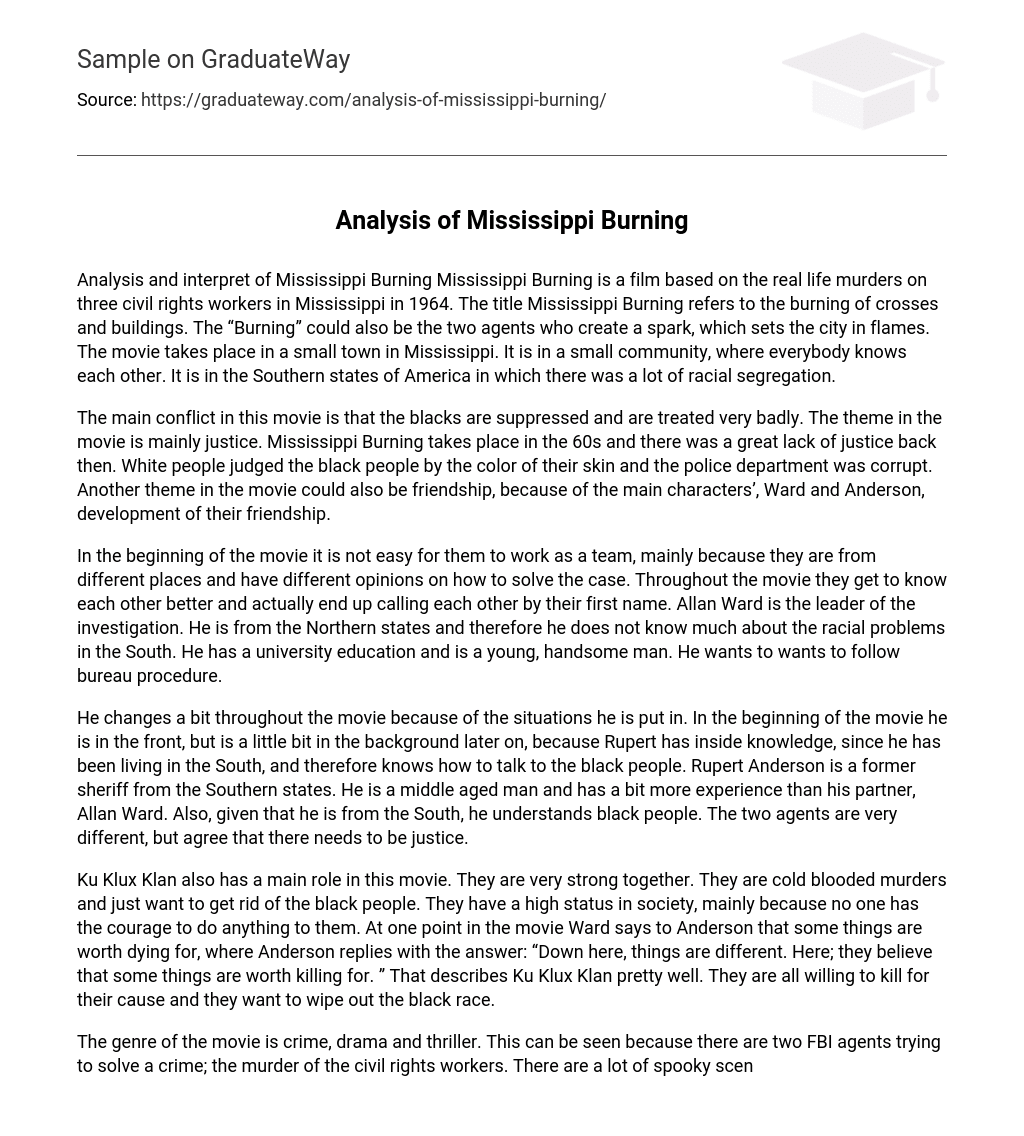Mississippi Burning is a film that portrays the true events of three civil rights activists being murdered in Mississippi in 1964. The title, “Mississippi Burning,” refers to both the burning of crosses and buildings, as well as the actions of two agents that ignite a destructive fire which consumes the town. This story occurs within a closely-knit community situated in a small Mississippi town, where familiarity among residents is common knowledge. The narrative unfolds amidst the prevalent racial segregation that existed throughout Southern states in America.
The primary conflict in this film focuses on the mistreatment and oppression of black individuals. Justice is the central theme throughout Mississippi Burning, which is set in the 1960s when a lack of fairness prevailed. The black community faced discrimination based on their skin color, while corruption plagued the police department. Additionally, friendship emerges as another prominent theme as Ward and Anderson, the main characters, develop their bond.
At first, the characters in the film encounter challenges collaborating as a team due to their diverse backgrounds and contrasting approaches to resolving the case. Nevertheless, as the narrative progresses, they develop a deeper understanding of one another and begin using their given names when addressing each other. Leading the investigation is Allan Ward, an attractive young man hailing from the Northern states who is unfamiliar with racial matters in the South. Having attained a university education, he places great significance on adhering to bureau protocols.
Throughout the movie, Rupert Anderson undergoes a transformation due to the situations he encounters. Initially, he is more prominent, but later, he takes a step back as Rupert possesses insider information having lived in the South and knows how to communicate with black individuals. As a former sheriff from the Southern states, Rupert is an experienced middle-aged man who understands the black community, unlike his partner Allan Ward. Despite their differences, both agents share a mutual belief in the importance of justice.
The Ku Klux Klan plays a significant role in this film, exhibiting great strength and a ruthless desire to eliminate black individuals. Their social status remains elevated due to society’s cowardice in opposing them. In a pivotal moment, Ward enlightens Anderson that certain matters are worth sacrificing one’s life for. Astonishingly, Anderson retorts with, “In this region, the ethos varies. Here, they firmly believe in killing for their convictions.” This statement aptly characterizes the Ku Klux Klan, as they demonstrate unwavering dedication and seek to eradicate the black community.
The movie is a crime, drama, and thriller genre. It revolves around two FBI agents who are tasked with solving the murder of civil rights workers. The film contains eerie scenes that can evoke fear and offense. Set in 1964, it follows the investigation into the disappearance of three civil rights workers, which leads the agents, Ward and Anderson, to uncover larger issues in the Southern town of Mississippi.
Agent Ward and Anderson discover a connection between the sheriff’s office and the Ku Klux Klan. Although Ward suggests following “bureau procedure,” Anderson, aware of the racial tensions in the South, proposes alternative methods. However, the local black community is too afraid of the Klan to provide any information to the agents. Realizing that conventional approaches are ineffective, the agents resort to unconventional tactics and abduct the mayor, who eventually confesses to the murders.
Although the agents cannot legally use this information, it helps them advance the investigation. They trick the KKK and get important details from a member named Lester Cowens. With valid evidence, the FBI agents effectively prosecute the culprits for civil rights violence. Most of the criminals are convicted and given prison sentences ranging from three to ten years. While the sheriff is found not guilty, sadly, the mayor commits suicide. The closing scene wonderfully captures the essence of the film as people of both races peacefully gather and sing during a Sunday morning service.
The movie depicts the changing atmosphere as black individuals gradually gain more rights, but their progress is overshadowed by the immense pressure and challenges they face in trying to live a normal life. The film also highlights the strained relationship between white and black residents, which is practically non-existent due to fear caused by racism. When FBI agents enter the community, it intensifies the racial conflict and shifts the focus from merely lacking justice to actively pursuing it. The perspective presented in the film comes from a white man.
The omniscient third person narrator in this text provides an encompassing viewpoint, offering glimpses into scenes within the KKK and tracking the actions of its members. The narrator, displaying sympathy towards black individuals, portrays the members of the Ku Klux Klan as villainous and lacking compassion. Furthermore, the film’s overarching theme is to convey to viewers that there are no distinctions between black and white individuals. Pathos serves as the primary method of persuasion employed by the narrator, effectively tugging at the emotions of the audience.
There are numerous scenes depicting real-life killings, which may have a strong impact on viewers. This movie strongly resembles The Help, another film set in the 1960s that explores the racism faced by black maids working for white families. Both movies shed light on the mistreatment of black individuals and the severe reality of segregation. Despite being somewhat frightening, I truly enjoy Mississippi Burning and believe it is crucial for young people to witness the historical context and laws of that time period. This film is both educational and thrilling.





